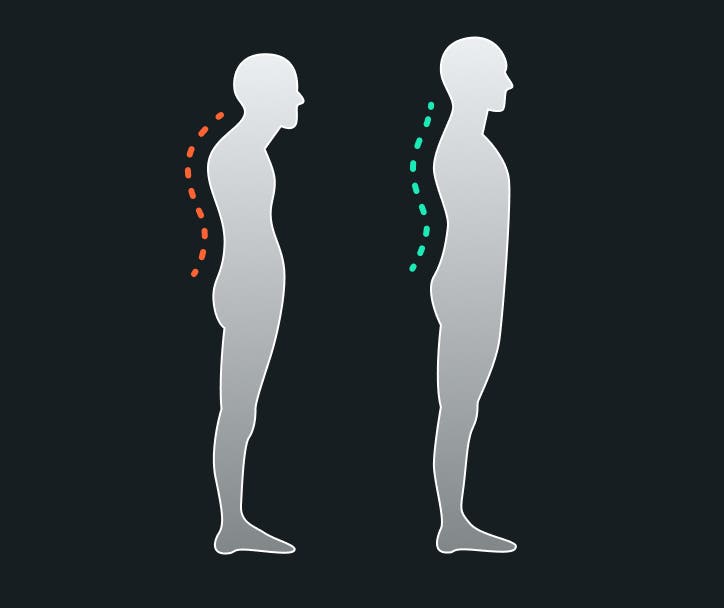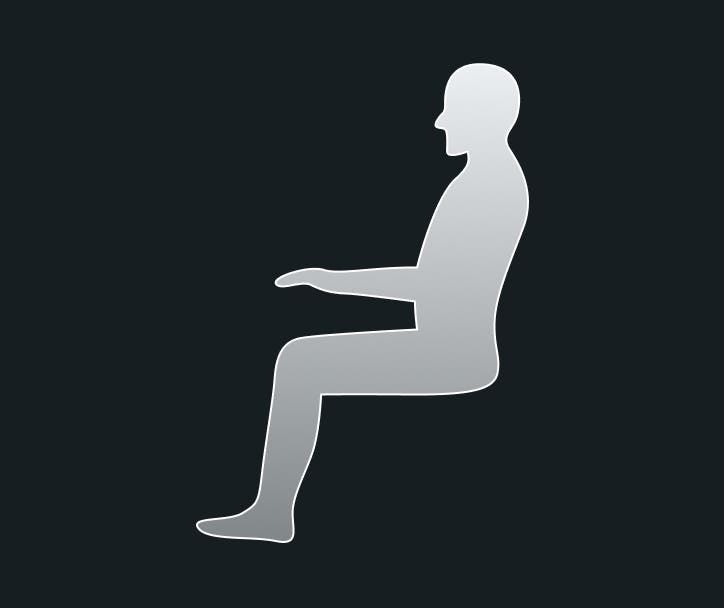Technology has revolutionized our lives. It’s made the world faster, smarter, and more connected than ever before. Whether you're reconnecting with distant loved ones or diving into a new culture from your couch, a world of information is just a tap away.
And while the benefits are undeniable, technology also takes a physical toll on us. The rise of "tech neck" and prolonged sitting has hit alarming levels, seriously affecting musculoskeletal health and overall well-being.
As we spend increasing amounts of time hunched over electronic devices and sedentary at desks, the negative effects on our posture, mobility, and health become more pronounced.
So how can we combat this problem? First, we need to understand it.
Understanding tech neck
Tech neck, also known as “text neck,” is characterized by the forward head and rounded shoulders posture commonly associated with prolonged device usage.
Smartphone users spend a whopping average of 3-4 hours per day with their heads tilted forward looking at a screen. And for most, it’s even more. And that doesn’t even include the rest of the day spent on computers, tablets, and video games.
In fact, adults in the United States spend an average of 6-8 hours per day engaged in sedentary activities. Yep, you read that right.
And the repercussions are significant. This sustained forward head posture can lead to a cascade of musculoskeletal issues, including muscle imbalances, tension, and discomfort.
Health consequences of tech neck
The human body has evolved to adapt to the demands and stresses that we put on it. This is well known in the training world as the SAID Principle. If you do lots of running, you will become faster and more efficient at running. If you lift weights consistently, you will build muscle and get stronger. The same principle applies when we sit or look at a device for hours each day.
Prolonged periods of forward head posture can place excessive stress on the cervical spine, leading to increased pressure on intervertebral discs and spinal structures.[1] This prolonged strain can even result in alterations to the curvature of the spine, contributing to postural abnormalities and spinal misalignment.
The muscles of the neck, shoulders, and upper back are forced to compensate and support the weight of the head in this forward position. Over time, this can lead to muscle fatigue, tightness, and weakness, further exacerbating the discomfort associated with tech neck.
Beyond the musculoskeletal implications, tech neck can have broader health consequences. Poor posture, including forward head posture, can impact respiratory function by reducing lung capacity and compromising thoracic mobility.[2] It can also lead to asthma or sleep apnea.
Unfortunately, that’s not all: prolonged screen time and sedentary behavior associated with tech neck have been linked to increased risk of obesity, cardiovascular disease, and mental health disorders.
How to combat tech neck
Be mindful of your posture
Maintaining proper alignment can help reduce strain on the spine and prevent postural issues.[3] Research indicates that good posture is vital for ensuring the health and optimal functioning of muscles and bones.
What’s more, good posture ensures that the spine maintains its natural curvature, with the cervical, thoracic, and lumbar regions properly aligned. This alignment distributes gravitational forces evenly throughout the spine, reducing stress on vertebral discs, ligaments, and nerves. By preserving spinal integrity, proper posture helps prevent musculoskeletal issues such as back pain, herniated discs, and spinal misalignment.
Good posture also helps muscles activate and function properly, ensuring they work together to support the body's weight and maintain stability. With correct posture, muscles are neither overstretched nor overly contracted, allowing for efficient movement and reduced risk of strain or injury.

How to perfect your posture
Let’s be clear, there is no such thing as a “perfect posture”. However, having an awareness of your body alignment, making some ergonomic adjustments if you’re sitting or standing for long periods, and regular movement will help alleviate or prevent tech neck.
If a certain posture or position causes discomfort or pain, you should make an adjustment.
Here are some guidelines to help you correct any bad habits:
Standing posture
- Align your feet: Stand with your feet hip-width apart, ensuring that your weight is evenly distributed. Avoid locking your knees and keep them slightly bent to reduce pressure on the joints.
- Engage your core: Activate your core muscles to support your spine and maintain stability in the torso. Engage your deep core muscles by drawing your navel towards your spine with very gentle tension. It should be easy to talk, move, and breathe.
- Straighten your spine: Lengthen your spine from the base of your pelvis to the crown of your head, maintaining a neutral curvature. Avoid arching or rounding your lower back excessively, and aim for a straight, elongated spine.
- Relax your shoulders: Roll your shoulders back and down, allowing them to rest comfortably away from your ears. Avoid hunching or rounding your shoulders forward, which can strain the neck and upper back muscles.
- Position your head: Keep your head aligned with your spine, with your chin parallel to the ground.
Expert tip: It’s normal if you can’t maintain this position at first, but with practice, it’ll become a habit. Take a moment to check in with yourself. If you notice your head leaning forward, shoulders hunching, or core disengaged, take a deep breath in and lift the top of your head toward the ceiling. As you exhale deeply, let your shoulders roll back and down.
Sitting posture
- Get the right height: Select a chair with proper lumbar support to maintain the natural curvature of your spine. Adjust the height of the chair so that your feet can rest flat on the floor, with your knees bent at a 90-degree angle.
- Sit back in the chair: Sit all the way back in the chair, ensuring that your back is supported by the chair's backrest.
- Position your hips and knees: Keep your hips positioned slightly higher than your knees to encourage a neutral pelvic tilt. Ensure that your knees are at hip level or slightly below, with your thighs parallel to the ground.
- Maintain spine alignment: Sit up straight with your spine aligned from your tailbone to your head, maintaining the natural curves of your spine. Avoid rounding or arching your back excessively.
- Support your arms and shoulders: Keep your arms relaxed and close to your body, with your elbows bent at a 90-degree angle. Position your keyboard and mouse at elbow height with somewhere to rest your wrists to minimize strain.
- Adjust monitor height: Position your computer monitor at eye level, ensuring that you can view the screen without tilting your head up or down.
Expert tip: Just like with prolonged standing, take a moment to check in with yourself periodically or whenever you feel discomfort. Take a deep breath in while straightening and lengthening your spine, exhale, and roll your shoulders back and down to help get you into a better position. Repeat as necessary or as you become aware of your poor posture. The key here is developing awareness and building a new habit.

Regular strength training
Strength training interventions targeting key muscle groups affected by tech neck and prolonged sitting have demonstrated significant benefits in improving posture and reducing musculoskeletal discomfort.
Engaging in regular resistance training exercises can boost muscle strength, endurance, and postural control. Try incorporating exercises that target the neck, shoulders, and upper back to help alleviate symptoms of "tech neck" and promote spinal stability.
Start with some variations of:
- Overhead movements: Shoulder Presses, Pullovers
- Pulling with elevated elbows: Face Pulls
- Bench Press with a deep stretch at the bottom
Stretching and mobility
Regular stretching can also help to improve your posture. A daily stretching and mobility routine can ease muscle tightness and restore the range of motion compromised by poor posture and prolonged sitting.
Using evidence-based stretching protocols, like our 10-minute 360 Flexibility Flow, you'll be able to improve your flexibility and alleviate musculoskeletal symptoms by targeting muscles like the neck, chest, and hips.
Active breaks
Beyond perfecting your posture, try incorporating some active breaks into your daily 9-5 grind. Not only will it do wonders for your physical and mental health but it’s also a great and simple way to add some movement into a sedentary work routine. Bonus points – it can even help counteract all those negative effects of prolonged sitting.
Try implementing frequent micro-breaks to interrupt prolonged sitting bouts and promote physical activity. Go for a five-minute walk or pound out some Squats in the Freeletics app. That is all it takes.
Frequent breaks are effective in reducing sedentary time and improving metabolic health markers. Plus, they will help keep the energy up.
Let’s recap
Dealing with tech neck and the pitfalls of prolonged sitting requires a no-nonsense approach rooted in solid research and proven methods.
To tackle these challenges head-on, you need to nail your posture-improvement strategy, strength train, make stretching and mobility a top priority, and above all, take regular movement breaks. Taking action now is the best way to counteract the downsides of a sedentary lifestyle – and hit back at that pain in the tech neck.
Sources
[1] Punnett, L., & Wegman, D. H. (2004). Ergonomics of sitting at work and its impact on health: A review. American Journal of Preventive Medicine, 26(4), 275–284.
[2] Quek, J., Brauer, S. G., Treleaven, J., & O'Leary, S. (2012). The impact of posture on breathing and the implications for respiratory symptoms. Journal of Physiotherapy, 58(3), 171–178.
[3] Doe, J. (Year). Understanding Tech Neck: Causes, Symptoms, and Solutions. Journal of Musculoskeletal Medicine, 30(2), 45-58.